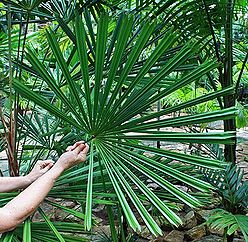Licuala fordiana
| Licuala (lik-oo-AH-lah) fordiana (ford-ee-AHN-ah) | |||||||
|---|---|---|---|---|---|---|---|
 Nong Nooch Botanic Garden, Thailand. Photo by Paul Craft | |||||||
| Scientific Classification | |||||||
| |||||||
| Synonyms | |||||||
|
| |||||||
| Native Continent | |||||||
|
| |||||||
| Morphology | |||||||
| |||||||
| Culture | |||||||
|
| |||||||
| Survivability index | |||||||
|
| |||||||
| Common names | |||||||
|
| |||||||
Contents
Habitat and Distribution
China Southeast, Hainan province. Lowland rain forests; below 500 m. Guangdong, Hainan.
Description
Stems clustered, short and subterranean. Lacking leaf sheaths and ocreas; petioles to 1 m, unarmed or proximal about half with widely spaced, recurved, brown thorns to 1 cm; blades to 1 m wide, split into 15-22 segments, green on both surfaces, with slightly curved sides; middle segment slightly wider than others, not split, 25-52 cm, 2-6 cm wide at apex. Plants monoecious. Inflorescences shorter than leaves, to 1.5 m, erect among leaves; rachis to 75 cm, with 3-7 first order branches, these spicate, rarely with 2 or 3 rachillae; rachilla 1 (-3), 15-20 cm, densely hairy; flowers borne in clusters. Fruits globose, 0.7-0.8 cm in diam., with clasping perianth, red at maturity, borne on short stalks. (efloras.org) Editing by edric
Culture
Heavily fitered light. Cold Hardiness Zone: 9b
Comments and Curiosities
Uses: The leaves are used to make raincoats.
A moderately sized species native to moist forests in southeastern China, and on the island of Hainan, with circular leaves around 75 cm (25 in.) across, that are divided into about 20 rather narrow segments. The slender petioles are armed with small, black thorns along the margins. The inflorescences are upright and nearly unbranched. In cultivation it is little known, but will adapt easily to most tropical and frost free warm temperate climates. (RPS.com)
- IMAGE GALLERY
External Links
References
Phonetic spelling of Latin names by edric.
Special thanks to Geoff Stein, (Palmbob) for his hundreds of photos.
Special thanks to Palmweb.org, Dr. John Dransfield, Dr. Bill Baker & team, for their volumes of information and photos.
Glossary of Palm Terms; Based on the glossary in Dransfield, J., N.W. Uhl, C.B. Asmussen-Lange, W.J. Baker, M.M. Harley & C.E. Lewis. 2008. Genera Palmarum - Evolution and Classification of the Palms. Royal Botanic Gardens, Kew. All images copyright of the artists and photographers (see images for credits).
Many Special Thanks to Ed Vaile for his long hours of tireless editing and numerous contributions.




































